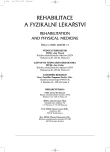Significance of Soft Parts in the Origin of Sacroiliac Dysfunctions in Posttraumatic Conditions of Lower Extremities
Authors:
M. Jendrichovský; P. Takáč 1 2
Authors‘ workplace:
Oddelenie FBLR, Nemocnica s poliklinikou, Stará Ľubovňa
1; Klinika FBLR, Fakultná nemocnica s poliklinikou, Košice
2
Published in:
Rehabil. fyz. Lék., 13, 2006, No. 1, pp. 24-28.
Category:
Original Papers
Overview
The function of sacroiliac joint consists in securing segmental stability. Painful stimuli interfering in locomotion subprograms result in destabilization, which becomes manifest in changes of the position and dynamics of sacroiliac joint, as demonstrated in development of asymmetry and present phenomenon of gaining (time). The limitation of free movements results in decreasing sector stability and subsequent development of inhibition programs which secure postural function. Changes may be observed especially in the soft parts, which play a dominant role in the formation of sacroiliac dysfunction. In the observed group the authors detected more frequent functional disorders in the region of sacroiliac articulation and pelvis in patients after injuries of lower extremities as compared with the control group. The paper was aimed at drawing attention to the need to include adjustment of these functional disorders into complex rehabilitation of posttraumatic conditions of lower extremities.
Key words:
sacroiliac dysfunction, stabilization, chain of functional disorders
Labels
Physiotherapist, university degree Rehabilitation Sports medicineArticle was published in
Rehabilitation & Physical Medicine

2006 Issue 1
Most read in this issue
- Possibilities of Therapeutic Climbing in Physiotherapy
- Cervical Spine in Relationship to Etiology Disorders of Cervical Region
- Clinical Significance of Trigger Point in Acromial Part of Deltoid Muscle
- Significance of Soft Parts in the Origin of Sacroiliac Dysfunctions in Posttraumatic Conditions of Lower Extremities
